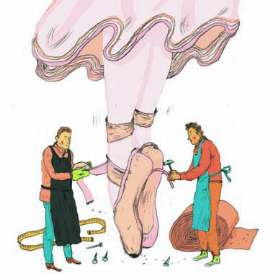Basic HTML Version

CULTURAL VOCABULARY
A GUIDE TO CURIOUS WORDS AND GESTURES FROMAROUND THE GLOBE
HEMISPHERESMAGAZINE.COM
•
APRIL 2012
23
ILLUSTRATIONS BY TIM VIENCKOWSKI (CULTURAL VOCABULARY)
Power Pointe
MEET THE UNLIKELY SHOE OBSESSIVES
KEEPING DANCERS ON THEIR TOES
At the end of a murky hallway in the
working-class east London neigh-
borhoodof Hackney, 12men standat
batteredworkbenches under unflat-
tering fluorescent lights. Onewields
a nail gun; another bangs away with
a hammer. Machines hum. There
is something severe and decidedly
masculine about the whole scene,
but what this factory, Freed of
London, churns out is about as dainty
as it gets: custom pointe shoes for
the world’s prima ballerinas.
The factory is managed by Gary
Brooks, who came to Freed straight
out of high school. “I was fascinated
when I first came here by howmuch
work goes into making a shoe,” he
says. “People either leave after six
months or, likeme, stay for 30years.”
The only things that have changed
since Freedwas founded in 1929 are
the soccer posters on the wall and
the songs coming from the radio.
LONDON
ISRAEL
If someone’s full of hot air, call
him on it by pointing at your
upturned palm—signaling that
grass will grow there before
his words come true.
nu:
This Yiddish word can
mean anything from “How did
it go?” to “Hi, what’s up?”
FINLAND
When passing the salt, set it
down on the table instead of
handing it off directly, which
would invite bad luck.
kurrku:
Equally important
in doctors’ offices and
restaurants, this means both
“throat” and “cucumber.”
COLOMBIA
Recalculate your tip if you
see your waitress tapping
the underside of her elbow,
which indicates you’ve been
a bit stingy.
avión:
The Spanish word for
airplane is also a colloquial
term for a clever person.
POLAND
Flicking a finger against your
neck is shorthand for “Want to
get a drink?” (usually vodka).
bułka z masłem:
In Poland,
something easy isn’t described
as a “piece of cake” but rather
a “roll with bu er.”
Each craftsman makes 40 pairs
a day, all of which start with the
same basic materials: satin, cotton,
burlap, cardboardand leather. But, as
with violinmakers and their varnish,
rumors abound of top-secret ingre-
dients being added along theway to
make one man’s shoes more prized
than another’s. Because of this, once
a dancer finds a craftsman she likes,
she tends to stay with him for her
entire career. In turn, the shoemakers
take great pride in nabbing the
best ballerinas. “I’ve had some top
dancers—Tamara Rojo and Belinda
Hatley,” says Pat Moran. He’s been
at it for 18 years, he says, “and I still
remember the times I’ve come to
work and made the perfect shoe.”
That’s not to say the craftsmen
often see their handiwork in action.
In fact, Brooks is unusual among his
colleagues in that he’s actually been
to the ballet. “I really enjoywatching
their feet and what they do. It gives
you a whole different view,” he says.
“Butmost of the blokes think it’s a bit
girly.”
—MARCIA ADAIR
THEWORLD

